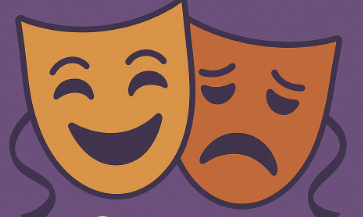Although depression is the most common sign of Bipolar Disorder, it’s the manic stages that define the disorder, and the way that a person experiences them, into these different types. Many people who experience the “feel good” mania, or the highs of some types of bipolar, usually aren’t mentioned to a person’s Dr. They’re either new to be treated, and don’t realize it’s part of the illness, or they don’t see it as a problem worth mentioning. Even though it results in a depressive fallout when the “fun” feelings goes away.
This alone causes so many people to be misdiagnosed and not receive the actual treatment they need to get better. If you go to your Dr and say, “hey Dr, I’m feeling depressed and I may think I have Bipolar Disorder”, you’re probably leaving there with antidepressants, and nothing else. If you do have Bipolar disorder, and take antidepressants alone, it literally can add rocket fuel to the manic symptoms. It’s strongly important to learn more about the illness, and how you personally experience it.
Bipolar Type 1
This is the category that I fall under, and those with this, can and/or will experience mania (what we call “full-blown mania”). This does go far beyond that “feel good” mania that I mentioned earlier. What is mania you might ask? It’s extreme agitation, grandiose thoughts or beliefs, up to psychosis and delusions. It’s basically the end of the road for us. Even a full blown manic episode, during your lifetime, that lasts for at least a week can determine if you live with Bipolar Type 1 Disorder. Regardless of your history or experience with depression.
Now, there are always exceptions, and we all experience this differently. Full blown mania can also be the cause of certain medication side effects, drug or substance abuse, and other factors in people’s lives. It is common for good Drs to take their time and know you, before they just hand you a diagnosis.
Many people end up with a type 1 bipolar diagnosis after being hospitalized, arrested, or a family member is finally insisting that they get help. It’s hard, because a lot of us don’t see the symptoms ourselves even though they’re really obvious to everyone else around us. This is normal, and part of the illness.
Bipolar Type 2
This is where hypomania does come into play. People with type 2 will experience one major depressive episode in conjunction with at least one hypomanic episode. This is a really tough one to diagnose, because Drs have a hard distinguishing major depressive disorders and actual bipolar disorder. So many people fail to mention or even realize they experience hypomania.
When you have so much energy, you almost feel high. Your self-esteem or creativity or confidence goes through the roof. Who would think there is a problem with that? If a Dr is asking about past history, of course we’ll remember being hospitalized or arrested, but most people won’t remember that crazy fun few days that happened, 8 months ago.
Type 2 can be very elusive, and unfortunately periods of debilitating depression tend to last a very long time with people who live with this. I’m talking months, or even years with people. When that hypomanic state comes back, many people think that the depressive state went away and that they’ve been “cured”. Until that nasty cycle starts all over again.
Bipolar Type 3 (Cyclothymia Disorder)
This is often called, “bipolar’s little cousin”. Although it’s a milder form of bipolar disorder, mild does not mean, simple or easy. Cyclothymia means feeling of nagging depression, not severe enough to where it is debilitating. It involves mania, but not as intense as hypomania or mania.
These symptoms can last for long periods of time. The diagnostic criteria for people with this disorder is that people need to cycle frequently for at least 2 years. People with cyclothymic will not stay euthymic (stable) for more than two months at a time before experiencing another depressive or manic episode again.
Now there is a BIG difference between the normal moodiness we all experience as part of being a human being and an actual illness that affects our ability to work, our relationships, school, and our personal lives in a very negative way. It’s also really important to know that Bipolar disorder is a progressive illness. That means it can get worse, or progress to a different type if left untreated.
Type 4, Bipolar Disorder NOS
Now moving forward, those that are given a diagnosis Bipolar Disorder: Not Otherwise Specified (NOS). This is sometimes called, “other specified bipolar”. Many Drs, who are aware there is a state of a serious mood disorder, but still trying to narrow down a specific diagnosis. WIll sort of use this as a stop gap, while they are observing our symptoms.
I know this can be really frustrating for some people looking for answers. This doesn’t mean that the Dr doesn’t know what they are doing, but it’s a way to look at a starting point, and a way to start receiving treatment that might help them feel better. Like I mentioned before, it can take time for a Dr to get to know who you are, before they can make an accurate diagnosis.
If you are diagnosed with Bipolar NOS, it is crucial that you maintain those appointments or contact with your Dr, so you can achieve an accurate diagnosis and then move on to the best possible treatment approach.
The next 4 types are called “core specifiers”. These aren’t specifically types of Bipolar disorder, but they are very commonly attached or added to types of bipolar disorder diagnosis.
Rapid Cycling Bipolar Disorder
This summarizes as people who cycle faster or more frequently through the symptoms. Such as mania, depression, agitation, or mixed states. Within a much shorter period of time, than people with typical bipolar diagnosis.
Patients who cycle, must experience 4 or more separate mood episodes within a single year to be diagnosed with this core specifier. Now some of us may cycle more often than just 4 times a years, but that just goes with the criteria of what the diagnostic is for rapid cycling. It’s what I like to call, ” rapid relapsing”, where you go from one episode, immediately to another. It is very confusing for those around us to watch switch mood polarities so quickly.
Bipolar with Psychotic Features
Now, this is a nasty one for us, in my opinion, and this is my core specifier to my Bipolar Type 1 disorder. This can happen in either a manic or depressive episode. Basically, we lose touch with reality and cause a lot of us to end up in the hospital, or even jail.
Psychosis is usually associated with type 1 Bipolar, where we go far beyond mania and lose ourselves in the illness. It can include delusions, like believing things are obviously not true. Extreme paranoia, like thinking we’re being monitored by the government or other people. Thinking we are some kind of celebrity or religious figure or even some special mission to save the world. Such as God has chosen us to do something grandiose. When I tell you there is more, there is more. It can progress to cases of hallucinations, like hearing voices.
This is one of the more serious aspects of the illness. For some of us, our depression or mania can get so bad that it can cause us to be catatonic. Such as we can’t move or talk. It’s horrible to say the least. If you aren’t educated with mood disorder, such as bipolar disorder, this is what the media and other people have stigmatized or blown so far out of proportion.
Yes, these are very serious symptoms, but it’s a VERY small number of people who have them, and it doesn’t happen all the time. The next time you hear the word Bipolar, it would be irresponsible to think that it’s just someone who is psychotic all the time. It is only a rare part of the illness, a core specifier, and not even an actual type of bipolar disorder.
Bipolar Disorder with Mixed Features.
This is basically a feature for those who live with mixed episodes often enough, to where it is added with a diagnosis as a core specifier. This is where we can be extremely depressed, and manic at the same time.
Mixed states for me personally, are horrible. I once felt so depressed that I couldn’t crawl out of bed, but I’m so full of anxiety or mania at the same time. Some people call this, mixed mania, mixed states, or even dysphoric mania. We can be extremely depressed, and agitated or angry at the same time.
Bipolar Disorder with Anxious Distress
This one is a rare specifier, I just recently heard of this one. Those of us who live with bipolar disorder, will also experience panic attacks, or severe anxiety. This happens enough to where it becomes a dominating factor in our bipolar experience. Instead of meeting the full criteria of generalized anxiety. Dr’s will at least note this so people are aware that we go through this regularly.


